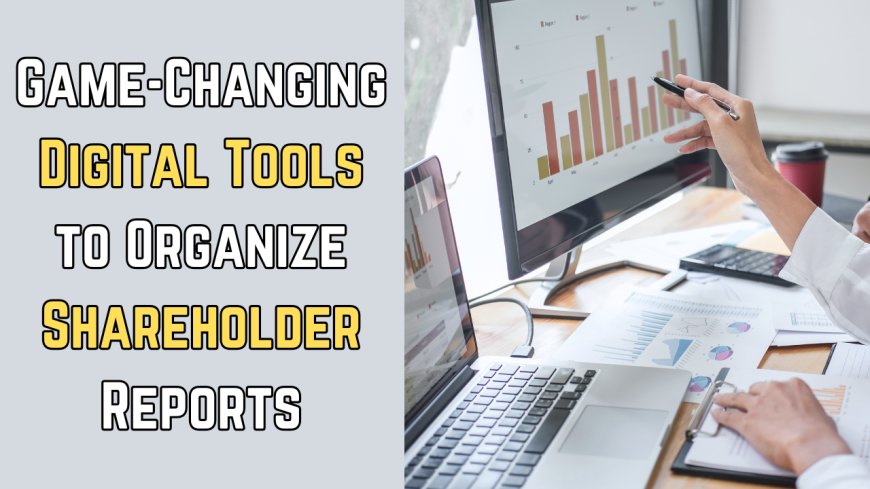Game-Changing Digital Tools to Organize Shareholder Reports
Discover game-changing digital tools to organize shareholder reports effortlessly. Save time, improve accuracy, and streamline reporting.

Key Takeaways
-
User-friendly tools require minimal training.
-
Real-time collaboration enhances team efficiency.
-
Accuracy checks prevent data errors.
-
Scalability supports growing data needs.
-
Optimized visuals improve report quality.
-
Best practices boost tool effectiveness.
Shareholder reports preparation is an essential process in maintaining transparency and effectiveness in communication with stakeholders. However, this process comes with the challenge of handling large datasets, with accuracy, and consistency in a professional format. Such challenges may lead to the consumption of more time and possible errors while organizing shareholder reports. Fortunately, the evolution of advanced digital tools has changed this process to present solutions that can facilitate the process, enhance the quality of the report, and save time.
Volume of Data: Managing Large Datasets from Diverse Sources: Shareholder reports are usually comprised of abundant data from a variety of sectors such as financial, legal, and operations. The sheer volume of all this data can cause delays and hardships in ensuring data is integrated correctly when using manual processes. This only gets more challenging with data from various formats like spreadsheets, financial systems, and databases that have to be consolidated and processed with caution.
Formatting & Consistency: Ensuring a Professional and Cohesive Look: It is daunting to make a large report appear cohesive, especially when sections are contributed by the different departments in various formats. The entire report must look professional and uniform if the organization is to remain credible among its stakeholders. Tools that automatically format this report and make it uniform throughout could help alleviate this challenge.
Accuracy: Avoiding Errors in Data Presentation and Calculations: Accuracy is important because the errors would misrepresent the performance of a company and possibly trigger legal effects. Consider a situation where a wrong data presentation or calculation has far-reaching decision effects. For instance, most reports usually go through auditors and regulators; hence the data accuracy should be within the boundaries of the firm's performance. It builds confidence for compliance.
Key Features of Digital Tools for Shareholder Reports

With these key features, digital tools enhance the efficiency, accuracy, and security of managing shareholder reports to become an indispensable tool in today's corporate world.
Data Management: Handling Big Data Effectively: One of the most challenging tasks in preparing shareholder reports is managing large volumes of complex financial and operational data. Digital tools assist in automating data gathering, integration, and processing, which lowers manual input and minimizes the chance of mistakes. These tools can effectively compile data from various sources, including Excel sheets, databases, and financial systems, to guarantee that the information is precise and current. For example, a study shows that a retail firm succeeded in cutting the time required to create reports by 50% following the adoption of an automated reporting system.
Customization Options: Tailoring Reports to Meet Organizational Standards: All digital tools allow companies to customize reports according to specific organizational needs and other regulatory requirements. It could be a matter of adapting the layout, adding company-specific branding, or incorporating certain kinds of metrics. Such freedom in designing shareholder reports makes these solutions highly flexible. Customized reports not only help build reports that are aligned with the identity of the corporation but also meet industry requirements and legal standards.
User-Friendliness: Accessible Tools for Non-Technical Staff: Data management and customization are important but not as important as ensuring that the digital tools are user-friendly. The tools should allow non-technical staff to work on them without much training and support from IT. Most modern digital tools have very intuitive interfaces, drag-and-drop features, and very simplified workflows, thus allowing users who have no technical expertise.
Collaboration and Real-Time Updates: Simplifying Team Collaboration: As the business environment continues to rush, it becomes impossible for companies to prepare shareholder reports without the aspect of teamwork. Digital tools enable teams to make real-time updates as individuals work on the same report no matter where they are located in the world. This will minimize bottlenecks in the system, enhance efficiency, and ensure that all stakeholders obtain the latest information.
Security Features: Protecting Sensitive Information: With sensitive financial and operational data in shareholder reports, data security is at the top of the list. Digital tools are typically very secure tools, like encryption, password protection, and restricted access so that only authorized personnel may view or modify the documents. Such security measures prevent unauthorized access and data breaches, thereby reducing the possibilities of financial fraud or violations of compliance. According to a report states affirm organizations with strong security awareness were 30% less likely to experience a data breach.
Digital Tools and Their Applications
Image Optimization: Image optimization tools are very important in enhancing the visual quality of shareholder reports. These tools can remove backgrounds from images, improve resolution, and adjust layouts to align with the report's overall aesthetic. For instance, optimizing the company logo or cleaning up infographics ensures that visuals appear clear and professional, reinforcing the organization's credibility. By improving the quality of images, these tools ensure that reports are visually appealing and effectively convey key messages.
Merging and Splitting PDFs: Merging and splitting PDFs makes the process of collating and managing report content much easier. By combining various reports like financial data, strategy outlines, and market analysis in one document, the cohesive, all-in-one shareholder reports will become easily maneuverable. On the other side, breaking large reports into many sections allows for distribution focusing on specific data for various departments and stakeholders. This function delivers efficient communication and selective, targeted content without diluting the integrity of the message.
Export to PDF: This can be presented as financial information professionally and securely through converting Excel spreadsheets to PDFs. Financial summaries, balance sheets, and key performance indicators can easily be changed to non-editable easy-to-read reports with no possibility of alteration. Thus, uniform formatting of data reduces the complexity of presenting data and ensures easier accessibility by the stakeholders. For instance, in a shareholder report, a PDF version of the same financial data will maintain the consistency of presentation and provide safety from the data.
Advantages of Implementing Electronic Tools in Report Management

This integration of electronic tools into report management helps streamline the process, with a consequent impact on the overall quality and security of shareholder communications.
Efficiency
Digital tools enable the automation of repetitive activities, including data input, formatting, and report generation. Functions such as auto-fill and pre-defined templates minimize the time required for report preparation. A study conducted by McKinsey & Company indicates that automation may cut administrative tasks by 20-30%, allowing teams to concentrate on more strategic areas. Companies can handle intricate data and produce reports significantly faster, resulting in prompt decision-making.
Professionalism
Digital tools ensure that the reports are formatted consistently, free from errors, and visually appealing. The more advanced PDF editing tools help make them more readable, and features such as automated checks ensure that nothing gets missed. For example, if financial statements need precise alignment and clarity, this is easily achieved with digital tools.
Collaboration
Digital tools make it easy for teams to collaborate on shareholder reports. Cloud-based platforms allow various users to collaborate on a document at the same time, providing real-time updates and reducing version control problems. This ability is particularly crucial in larger organizations where various departments might need to participate in or authorize reports.
Security
Managing sensitive shareholder information is sensitive and requires security. Digital tools offer features such as encryption, password protection, and access control that allow only authorized personnel to look at reports or make any modifications. Such features significantly reduce risks associated with data breaches and unauthorized access -- factors critical for the maintenance of stakeholder trust.
Accuracy
Digital tools reduce the chances of manual mistakes through built-in validation tools and error-checking algorithms. Automated calculations and cross-checks ensure that data remains consistent throughout the report.
Scalability
Digital tools also enable businesses to scale their reporting processes as they grow. Whether managing reports for a small set of stakeholders or large institutional investors, these tools can adapt to increasing data volumes without compromising on speed or quality. This scalability ensures that companies can maintain efficient reporting practices as their operations expand.
Best Practices for Using Digital Tools

By following these best practices, organizations can maximize the efficiency, accuracy, and security of their shareholder reporting processes while fostering a culture of accountability and professionalism.
1. Regular Software Updates
You must update your digital tools to achieve maximum functionality and security. Many updates include fixes of critical bugs, improved performance, and new features that may speed up shareholder report preparation. So check for regular updates to use all your tools at full capacity.
2. Save your files in secure locations
Data loss can be catastrophic, especially when it is shareholder information. Always backup files in safe locations, such as encrypted cloud storage or external drives. Consider implementing automated backups to reduce the chance of losing vital documents because of technical failures or cyberattacks.
3. Train Employees to Use Tools Efficiently
The most advanced digital tools can only be as effective as the person operating them. Conduct regular training sessions to familiarize your team with key functionalities, shortcuts, and best practices. This is not only about boosting productivity but also ensuring consistency and professionalism in report preparation throughout the organization.
4. Establishing a File Organisation System
An effective file management system ensures there is easy and fast access to documents, which can be achieved using descriptive files, standardized formats, and organized folders. This also avoids confusion by implementing versions in case of outdated or duplicated files.
5. Maintaining Data Privacy and Security
Utilize only digital tools with high-security measures and protect your sensitive files through restricted access. Sensitive files are secured using a password. Check and verify your permission frequently.
6. Test the tool before deployment
Test your new reporting tool, or at least, try testing your new tool on various functions, before implementing it on the full process. In this way, you do not disrupt any process of work while having a chance to resolve potential issues ahead.
7. Leveraging Collaboration Features
Most modern tools include collaboration features such as shared editing, real-time comments, and role-specific access. Utilize these to streamline teamwork and ensure all stakeholders can contribute effectively without compromising document integrity.
Sum Up
Incorporating digital tools into the preparation of shareholder reports is no longer a luxury but a necessity in today’s fast-paced and data-driven business environment. These tools address key challenges such as managing large datasets, ensuring accuracy, maintaining professionalism, and enhancing collaboration. By streamlining processes, fostering data security, and enabling customization, digital tools empower organizations to deliver clear, cohesive, and compliant shareholder reports.
Adopting best practices, such as regular updates, secure file management, and staff training, further enhances their effectiveness, ensuring that companies can meet the evolving demands of stakeholder communication with efficiency and confidence.
What's Your Reaction?
















